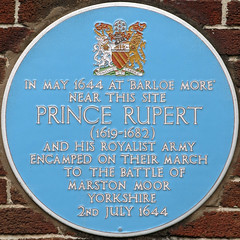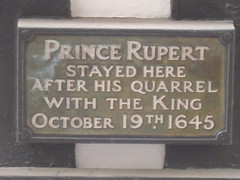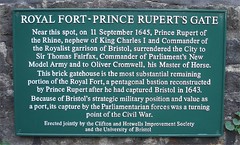Prince Rupert


Prince Rupert
(1619-1682)
Prince, Count Palatine of the Rhine, 1st Duke of Cumberland (1644-1682), and 1st Earl of Holderness (1644-1682)
nephew of Charles I
Commemorated on 4 plaques
In May 1644 at 'Barloe More' near this site Prince Rupert (1619 - 1682) and his Royalist Army encamped on their march to the battle of Marston Moor, Yorkshire, 2nd July 1644.
Didsbury Library, 692 Wilmslow Road, Didsbury, Manchester, United Kingdom where they encamped with his Royalist Army
Prince Rupert stayed here after his quarrel with the King October 15th 1645
The Governor's House, Newark-on-Trent, United Kingdom where they stayed
Royal Fort - Prince Rupert's Gate. Near this spot, on 11 September 1645, Prince Rupert of the Rhine, nephew of King Charles I and Commander of the Royalist garrison of Bristol, surrendered the City to Sir Thomas Fairfax, Commander of Parliament's New Model Army and to Oliver Cromwell, his Master of Horse. This brick gatehouse is the most substantial remaining portion of the Royal Fort, a pentagonal bastion reconstructed by Prince Rupert after he had captured Bristol in 1643. Because of Bristol's strategic military position and value as a port, its capture by the Parliamentarian forces was a turning point in the Civil War.
Prince Rupert's Gate, Bristol, United Kingdom where they surrendered
Site of the Ship Inn 1560 to 1972 During the Civil War this Inn was reputedly Prince Rupert's headquarters when he with a force of 2000 men attacked Birmingham on Easter Monday 3rd April 1643
Bordesley Middleway, Camp Hill Circus, Birmingham, United Kingdom where they headquarters when he with a force of 2000 men attacked Birmingham on Easter Monday 3rd April 1643 (1643)




